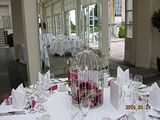

Asim Shah posted a photo:
beetography
basswood-DSC_4265.jpg

Pyracantha berries in Ben Lomond, CA USA
White and ample flower
beetography
chinesecherry-DSC_1641.jpg
beetography
ipomoea-DSC_0906.jpg
Bright yellow flower
Another yellow flower
pollen-flowers posted a photo

vintage birdcage with dome of roses and peonies with would jasmine - latest2034.jpg


Every year underwater - every year bearing rich harvest thanks you abundance in water during rainy season the soil is fertile and produces quantities of rice and aquatic life as most valuable food resources for all Cambodia.
Such sceneries are no exception but normal every year since a long time. As a result all Khmer culture has adapted to life with water, on water, surrounded by water and living from water resources.
In album Kingdom of Cambodia Pictures
Keywords:
Asim Shah posted a photo:
A few years ago if someone had mentioned gabions I wouldn't have known what they were talking about. They were something that was used in civil engineering, large scale industrial landscaping - a million miles away from domestic gardens. Now it seems they are becoming the cool thing to have.
 At Tatton there are gabions in the show gardens, in the back to backs and on the trade stands - people are taking home DIY versions!
At Tatton there are gabions in the show gardens, in the back to backs and on the trade stands - people are taking home DIY versions!
Basically a gabion is a metal - usually steel, cage filled with stones/rocks or various heavy materials. They are usually used to retain soil in banks and terraces or as barriers. I've seen taller, slim ones used as a wall and smaller, cubed ones made into seats - the permutations are endless, as demonstrated by the two young designers of the Visionary garden, Cubed3, at this year's Tatton.
 This gold medal winning design is a modular scheme, gabions are linked together like building blocks and used in different ways - some are filled with rocks as foundations, some are filled with soil and planted and some are placed in the pond, allowing you to walk over the water's surface. Larger cages have been left empty and plants are able to grow up through them - it's very effective.
This gold medal winning design is a modular scheme, gabions are linked together like building blocks and used in different ways - some are filled with rocks as foundations, some are filled with soil and planted and some are placed in the pond, allowing you to walk over the water's surface. Larger cages have been left empty and plants are able to grow up through them - it's very effective.
On the Edible Trends garden the Reaseheath College team have filled their gabions with carefully placed layers of stones and wood in decreasing sizes, creating a very pleasing pattern and a haven for wildlife. Apparently it took them ages to do but it looks fantastic.
A very 'green' way to fill your gabions is with odd bits of bricks, slates and tiles left over from building jobs, plus any empty bottles you may have accumulated. This is what they have used on A Place for Waste, another gold medal winning garden.
As you look around the show you will see all sorts of shapes and fillings and gabions used in many ways. I am feeling quite inspired and am planning to try something with sempervivums and I rather like the idea of turf cubes.
Info from:
Private Club









No comments:
Post a Comment